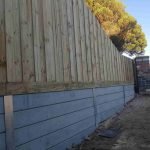Introduction: Structure a Greener Future with Maintaining Walls
In today's world, where ecological issues are at the forefront of social discussions, it's crucial to check out how different markets add to sustainability. Retaining wall builders stand as pivotal players in this story. Through innovative products and eco-conscious practices, they are reshaping landscapes while decreasing their eco-friendly footprint. This short article delves into the myriad methods modern-day keeping wall installers are embracing environmentally friendly methods, making sure that building does not come at the expense of our planet.

Spotlight on Eco-Friendly Practices by Modern Retaining Wall Builders
Understanding Eco-Friendly Practices in Construction
Eco-friendly practices describe methods and techniques that aim to minimize ecological damage. In the context of keeping wall building, these methods include making use of sustainable materials, waste reduction techniques, and energy-efficient procedures. But why should maintaining wall home builders care about being environment-friendly? The answer is basic: sustainability not just benefits the environment but also improves their reputation and business prospects.
The Role of Retaining Walls in Landscape Management
Retaining walls serve Tuff Stuff Retaining Walls multiple purposes beyond looks; they play a vital role in handling soil disintegration and water drainage. By implementing environmentally friendly practices, retaining wall contractors can boost these functions while minimizing their effect on the environment.
Sustainable Products: The Heart of Eco-Friendly Construction
Concrete Sleepers: A Long Lasting Choice with Less Impact
Concrete sleepers are a popular choice among retaining wall builders due to their durability and flexibility. They're frequently made from recycled materials, which helps in reducing waste. Utilizing concrete sleepers decreases the need for lumber, preserving forests and contributing positively to the ecosystem.
Timber Sleepers: Sourcing Responsibly
While wood sleepers like H beam, wood sleeper, or timber sleeper offer natural beauty and strength, sourcing them responsibly is crucial. Builders should ensure that wood originates from sustainably managed forests. This dedication not only protects biodiversity however likewise supports regional economies.
Stone: Nature's Classic Resource
Stone is another material widely used in keeping walls. Its long-lasting nature suggests less replacements over time, making it an eco-friendly option. Plus, when sourced in your area, it lowers transportation emissions significantly.

Innovative Strategies Used by Modern Builders
Green Engineering Concepts in Design
Modern retaining wall installers take advantage of green engineering principles to create designs that mix effortlessly with nature. This technique guarantees that structures support natural communities instead of interfere with them.
Use of Geosynthetics for Soil Reinforcement
Geosynthetics are artificial items that improve soil stability without invasive excavation methods. By using geogrids or geomembranes, professionals can decrease land disruption and promote natural plant life growth around keeping walls.
Minimizing Waste Throughout Construction
Prefabrication Techniques
Prefabrication enables constructing parts off-site before transferring them for assembly at the last location. This method substantially minimizes waste created throughout standard building processes.
Recycling Materials
Many modern maintaining wall builders prioritize recycling products whenever possible. For example, leftover concrete can be repurposed into aggregate for new projects or perhaps reused in landscaping features.
Energy Effectiveness in Construction Processes
Sustainable Equipment Choices
The equipment utilized by retaining wall contractors can have a considerable effect on energy intake. Selecting fuel-efficient equipment or electric machinery can considerably reduce carbon emissions during construction.
Integrating Native Plant Species
Integrating native plant species around keeping walls assists bring back local ecosystems while offering visual appeal. These plants require less water and upkeep than non-native species, making them a sustainable option for landscaping.
Community Engagement: Educating Customers About Sustainability
Educating clients about environmentally friendly practices cultivates a culture of sustainability within communities. When customers comprehend the benefits of ecologically conscious choices-- like choosing concrete sleepers or stone-- they're more likely to purchase sustainable solutions.
Certifications and Standards for Sustainable Practices
Many organizations offer certifications that recognize sustainable structure practices within the industry. Examples include LEED (Management in Energy and Environmental Design) accreditation, which encourages home builders to stick to strict environmental standards.
Case Studies: Effective Executions of Environmentally Friendly Practices
Examining successful jobs can influence others within the industry to embrace similar practices. For example:
- A project using recycled concrete sleepers demonstrated expense savings together with ecological benefits. Another case highlighted how employing native plants improved biodiversity around newly built retaining walls.
Economic Benefits of Eco-Friendly Retaining Wall Solutions
Investing in environmentally friendly options may have an upfront expense however results in long-term cost savings through minimized maintenance requirements and increased home value due to improved landscape aesthetics.
Overcoming Difficulties in Adopting Environment-friendly Methods
Despite increasing awareness about sustainability, some challenges persist:
Higher Preliminary Costs: Sustainable materials may have higher initial costs. Limited Accessibility: Not all regions have easy access to sustainable resources. Client Resistance: Some clients might focus on cost over sustainability initially.However, informing clients about long-lasting advantages can assist conquer these objections.
FAQs About Eco-Friendly Practices by Modern Retaining Wall Builders
What products are best for environmentally friendly retaining walls?- Sustainable options consist of concrete sleepers made from recycled content, properly sourced wood sleepers, and locally sourced stone.
- Look for specialists who display experience in sustainable practices and have pertinent accreditations or favorable evaluations regarding their environmental efforts.
- Yes! Lots of governments offer tax credits or rebates for environmentally friendly building and construction jobs that promote sustainability.
- Absolutely! Native plants are adjusted to local environments and soils; they generally need less water and maintenance compared to non-native species.
- Effective waste management through recycling methods decreases landfill contributions and promotes resource effectiveness throughout building projects.
- Yes! Existing structures can frequently be updated by adding sustainable landscaping features or using greener products when repair work are needed.
Conclusion: The Course Forward Towards Sustainable Retaining Wall Construction
As we've checked out throughout this article, modern keeping wall builders hold considerable potential to affect environmental stewardship through their practices-- from selecting sustainable products like concrete sleepers or stone to utilizing innovative design techniques that boost environmental health. By focusing on education and community engagement surrounding these subjects, they not just improve their organization potential customers however also contribute favorably towards building a greener future for generations ahead.
Ultimately, welcoming eco-friendly practices is not just a trend; it's becoming progressively important as we navigate difficulties associated to environment modification and urbanization-- making it imperative for each diligent contractor out there!